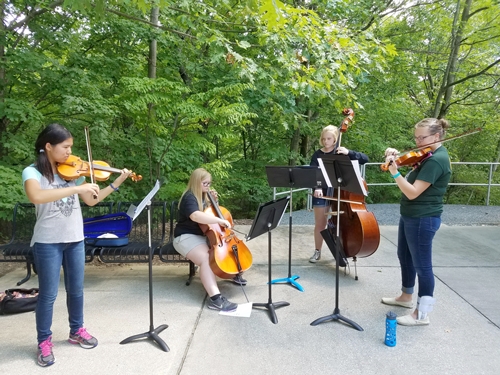To connect and integrate more deeply with all generations and cultures, arts organizations across the United States are spending more time and energy building their engagement efforts with today’s youth. While these organizations have a strong interest in increasing participation among younger adults, they often struggle to sustain interest and attendance. To better understand the motivations of young people, arts organizations in the area are providing opportunities for teens to lead through their own artistic expression. We talked with a handful of local organizations about what those opportunities look like and why they matter.
Holland Symphony Youth Advisory Committee
“An issue with the symphonic world is that the audiences are mostly people ages 50 and over,” said Lori Gramer, general manager and chief operating officer at the Holland Symphony Orchestra. “Getting young people involved is important. One way to do that is to encourage them to actively participate in the decision-making of the organization and help them understand why those decisions are made.”
This thinking was the genesis for the Holland Symphony Youth Advisory Committee (YAC), a program formed in August 2013. Through the program, high school musicians essentially act as interns with the Holland Symphony, learning leadership and advocacy skills along the way. The YAC also oversees the Holland Symphony Youth Orchestra and acts as a group of champions and ambassadors for people their age.
“This program is a two-way street,” Gramer said. “It’s for them to learn, and for you to listen. Without that relationship, what we do becomes stagnant.”
In contrast to more traditional, hierarchical structures and leadership practices often found in arts organizations, these youth leadership programs foster a culture of connectedness, collaboration and change. Students on the YAC partner with adult staff members to make suggestions and decisions that affect the youth orchestra. They also work together to organize fundraisers and social events for their fellow youth orchestra members, including an Oct. 21 retreat at Pine Trail.
Although most of the students in the YAC eventually pursue fields other than music, the value of arts leadership experiences resonates throughout all aspects of life.
“The collaboration and deliberation you learn playing in an orchestra are skills you can use anywhere,” Gramer said. “Many corporate organizations use the symphony model as a way to lead a successful business,” she said.
To summarize what she hopes students will take away from their involvement in the committee, Gramer points to a quote from American concert violinist Rachel Barton Pine: “As musicians, we are each blessed with a voice that can touch and transform. It is our responsibility to use it to make the world a better place for those around us.”
String Leadership Day
Henry Duitman is an associate professor and conductor of the symphony orchestra at Grand Valley State University. His String Leadership Day program equips participants with skills that are essential not just for a musician, but also in life beyond high school.
“Leadership in music has many applications,” Duitman said. “Musicianship requires discipline for many years. There are studies showing a high percentage of undergraduate music majors receiving acceptance into medical school. That ability to focus has value.”
Recognizing the need to train young string players and connect them to GVSU programs, Duitman started String Leadership Day to encourage high school musicians to build their leadership through music. Now in its ninth year, the program takes place on Oct. 21. The day includes time for rehearsals and individual focus in master classes, culminating in a performance that combines the high school participants with current GVSU music majors.
“String players are often followers, not leaders, because they usually play as a part of a large section,” Duitman said. “The idea is that when they go back to their school, they will be able to watch the conductor, listen more carefully and lead their section with confidence.”
As String Leadership Day has grown, Duitman also launched an intensive three-day camp in 2016 for students to explore performing in chamber ensembles during the summer.
Teen Leaders in the Arts
Grandville Avenue Arts & Humanities (GAAH) melds the approaches of the Holland Symphony Orchestra and String Leadership Day with its Teen Leaders in the Arts program. The program was launched in 2014 after Program Director Steffanie Rosalez noticed decreased retention in adolescents in the organization’s Cook Arts Center programs. Teen Leaders in the Arts is a youth-driven program in which participants drive the program’s vision and activities.
At the same time, the program promotes personal growth through artistic expression, opportunities to lead in the community and the free exchange of ideas. Teens in the program gain career experience, act as mentors to younger kids at the Cook Arts Center, and are regularly involved with grassroots arts activities in the Grand Rapids Community.
“To us, art is about learning a variable skill set, learning how to express yourself, and using that to understand the world around you,” Rosalez said.
The program originally started with eight students and has grown to include 30 kids. The teens currently are engaged in a process to hire a program assistant at GAAH to facilitate the program. As the neighborhood around the Cook Arts Center transforms over the next few years — a multi-million-dollar mixed-use development was announced last year — the role teens play in their community is more important than ever.
“We hope this is a space for kids to talk about certain issues they might not have the opportunity to talk about at school or even with friends,” Rosalez said. “It can act as a space for them to think of ways to do things better.”





